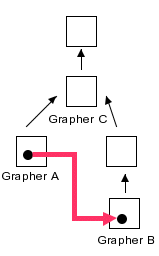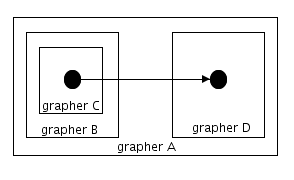To be able to create intergraph links, you must have a hierarchy of
nested graphers (IlvGrapher). The hierarchy should not contain
a manager ( IlvManager); otherwise the library will not
let you create an intergraph link.
Creating an intergraph link
Given that an intergraph link has an
origin and a destination in different graphers, the question that
arises is in which grapher the link is stored. The intergraph
link between a node stored in grapher A and a node stored in
grapher B must be stored in the first common ancestor of A and B,
as shown in the following figure.

Intergraph link in a hierarchy of
graphers
In this figure, the red intergraph link
that connects an object of A and an object of B must be stored in
grapher C, the first common ancestor of A and B.
The IlvGrapher class provides a static utility
method that allows you to determine the first common grapher:
static IlvGrapher getLowestCommonGrapher(IlvGraphic obja, IlvGraphic objb)
To create an intergraph link, the code
will look like this (assuming that the origin and destination
variables have been created and added in different graphers):
IlvGraphic origin, destination; IlvLinkImage link; ... link = new IlvLinkImage(origin, destination, false); IlvGrapher common = IlvGrapher.getLowestCommonGrapher(origin, destination); common.addLink(link, false);
The
IlvGrapher
.addInterGraphLink static utility method allows you to add the
link directly to the common parent grapher:
static void addInterGraphLink(IlvLinkImage link, boolean redraw)
The code shown in the previous example is
equivalent to:
IlvGraphic origin, destination; IlvLinkImage link; ... link = new IlvLinkImage(origin, destination, false); IlvGrapher.addInterGraphLink(link, false);
Accessing an intergraph link
The IlvGrapher class also provides methods that
let you access intergraph links stored in a grapher in an
efficient way:
IlvGraphicEnumeration getInterGraphLinks()
int getInterGraphLinksCount()
Since an intergraph link is stored in the same way as other links
in the grapher, it is also part of the list of all objects
contained in this grapher returned by the
getObjects
method of the class
IlvManager
:
IlvGraphicEnumeration getObjects()
Nevertheless, calling the
getInterGraphLinks
method is much more efficient than traversing all objects of the
grapher.
To distinguish an intergraph link from other objects in the
grapher, you can use the following method of the
IlvGrapher
class:
boolean isInterGraphLink(IlvGraphic obj)
This method returns
true
if the specified graphic object is a link stored in the grapher
instance with the origin or the destination stored somewhere
else. That is, if the graphic object is an intergraph link.
The IlvGrapher class also gives you access to
intergraph links that are leaving or entering a grapher. You can
access such links using the methods:
IlvGraphicEnumeration getExternalInterGraphLinks()
int getExternalInterGraphLinksCount()
The difference between the methods getInterGraphLinks
and getExternalInterGraphLinks is:
- The first method, getInterGraphLinks, returns the intergraph links stored in a grapher with an origin or destination in another grapher
- The second method, getExternalInterGraphLinks, returns the intergraph links stored in another grapher but with the origin or destination in this grapher
If the grapher has no subgraphers, the external intergraph links
obtained by getExternalInterGraphLinks()
are all links that are leaving or entering the grapher.
If the grapher has subgraphers, the
intergraph links that leave the grapher have one of the
following characteristics:
- An end node in this grapher
- An end node in a subgrapher of this grapher
Calling getExternalInterGraphLinks()
on the grapher gives only the links with an end node in the
grapher, not the links with an end node in a subgrapher of the
grapher.
In this case, links that are leaving or entering the nesting
hierarchy of the grapher can be obtained by examining all
external intergraph links of the subgraphers recursively. To help
in this task the following convenience methods are supplied: getTreeExternalInterGraphLinks and getTreeExternalInterGraphLinksCount.
When a grapher is moved, it is possible
that the grapher and all its nested subgraphers appear at a new
location on the screen. The grapher displacement causes the shape
of the following links to change:
- All links that are directly connected to the grapher. That is, have the grapher as origin or destination.
- All links that are obtained by
grapher.getTreeExternalInterGraphLinks().
The following figure illustrates
interlinked nested graphers:

External intergraph link
Grapher A contains two graphers, B and D.
Grapher B contains another grapher, C. The intergraph link from
an object of C to an object of D is then stored in A.
This link is an intergraph link of A (returned in getInterGraphLinks called on A) and is also
an external intergraph link of C and D (returned by getExternalInterGraphLinks called on C or
D).
Neither the origin nor destination of the intergraph link ends in
grapher B, and thus this link is not returned by calling
getExternalInterGraphLinks
on B. However, the link is returned by calling getTreeExternalInterGraphLinks on B, since
its origin node is nested inside B.